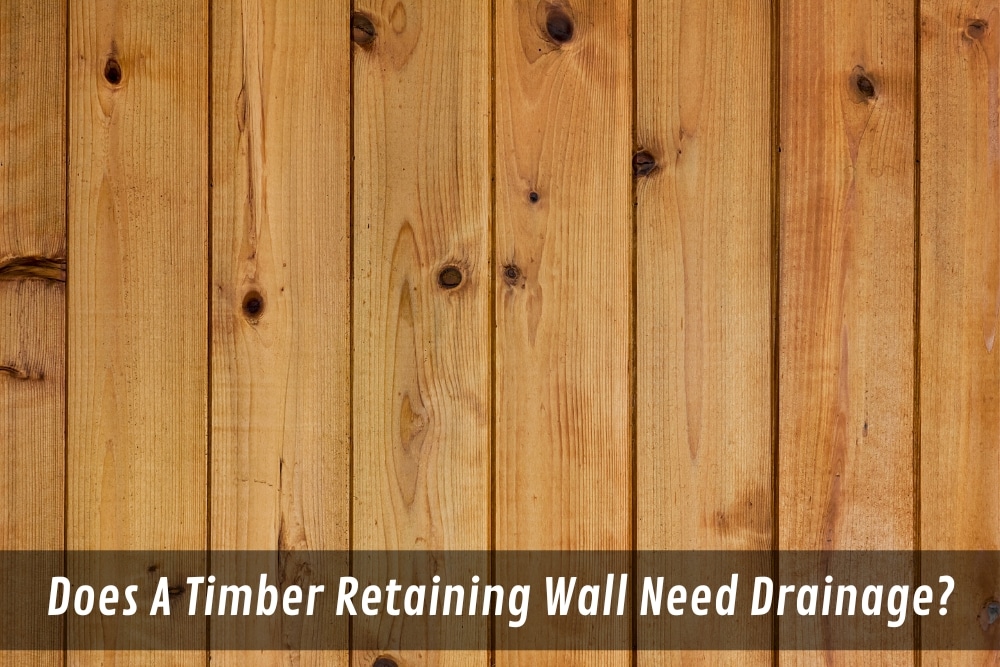If you’re planning on building a timber retaining wall on your property, you’re probably wondering whether or not it needs drainage. After all, a poorly constructed retaining wall can cause a lot of problems, including soil erosion and flooding. But is drainage really necessary?
Retaining walls are a popular landscaping feature that can add both beauty and functionality to your yard. However, there are many factors to consider when building a new wall, including the materials you choose and the surrounding soil conditions. With timber retaining walls in particular, drainage is a common concern for many homeowners.
Although timber retaining walls do not necessarily require drainage in all cases. It’s important to evaluate the specific conditions of your property before beginning construction. In this article, we’ll examine the pros and cons of adding drainage to your retaining wall, as well as some tips for ensuring the wall’s long-term stability and effectiveness.
What is the Importance of proper drainage in retaining walls?
Retaining walls need proper drainage to avoid hydrostatic pressure buildup. This pressure can cause the wall to fail by tilting, cracking, or collapsing. Water accumulation behind a retaining wall exerts a significant force on the wall. To ensure the wall’s stability and longevity, proper drainage is necessary to relieve this pressure.
It’s important to note that proper drainage alone may not be enough to prevent retaining wall failure. The retaining wall design, materials used, construction methods, and site preparation are all critical factors that can affect the wall’s stability and durability.
What are the different types of drainage systems that can be used for timber retaining walls?
There are several types of drainage systems that can be used for timber retaining walls, depending on the specific design and site conditions. Some common options include:
- French Drain: A French drain is designed to redirect water away from a wall. It consists of a trench filled with gravel or rock and features a perforated pipe. This drain is installed behind a retaining wall and slopes away from the wall to guide water to a specific location.
- Weep Holes: Weep holes serve as drainage outlets located at the base of walls. They can be added through drilling timber regularly or integrated into pre-existing retaining wall systems.
- Drainage Fabric: Drainage fabric, or filtre fabric, is a geotextile material. Its purpose is to let water pass through while stopping soil particles from blocking the drain. It can be put behind a retaining wall to aid in water drainage.
- Perforated Drainage Pipe: To collect water and direct it to a specific location, a perforated drainage pipe can be installed behind a wall. This pipe is typically surrounded by gravel or rock, which helps to encourage water flow.
- Surface Drainage: To direct water away from a retaining wall, surface drainage is used by grading the surrounding soil. This technique is particularly useful for small retaining walls or walls located in areas with minimal rainfall.
It’s important to consult with a qualified engineer or contractor to determine the most appropriate drainage system for your specific retaining wall project. Proper drainage is essential to ensure the stability and longevity of the wall.
What is the installation process for drainage systems in timber retaining walls?
The installation process for drainage systems in timber retaining walls can vary depending on the specific system being used. However, there are some general steps that are typically involved in the installation process:
- Excavate the area behind the retaining wall where the drainage system will be installed. The depth and width of the excavation will depend on the size of the wall and the drainage system being used.
- Install any necessary filtre fabric or geotextile material to prevent soil particles from clogging the drainage system.
- If using a French drain or perforated drainage pipe, lay a layer of gravel or rock at the bottom of the excavation to promote water flow.
- Install the drainage system according to the manufacturer’s instructions. This may involve laying the perforated pipe, connecting sections of the pipe, and installing any necessary fittings or adapters.
- Cover the drainage system with a layer of gravel or rock to protect it from damage and promote water flow.
- If using weep holes, drill holes at regular intervals along the base of the retaining wall. Be sure to space the holes evenly and avoid drilling too close to the edges of the timber.
- Backfill the area behind the retaining wall with soil, being careful not to damage the drainage system.
What are the pros and cons of installing drainage in timber retaining walls?
There are several pros and cons to consider when installing drainage in timber retaining walls.
Pros:
- Prevents hydrostatic pressure: Drainage systems help to prevent the buildup of hydrostatic pressure behind the retaining wall. This pressure can cause the wall to fail, leading to costly repairs or even collapse.
- Reduces soil saturation: Proper drainage helps to reduce soil saturation. It can improve the overall stability and longevity of the retaining wall.
- Increases durability: By reducing the amount of water that comes into contact with the timber, drainage systems can help to increase the durability of the retaining wall.
- Prevents erosion: Drainage systems can help to prevent soil erosion and the loss of material behind the retaining wall.
Cons:
- Adds to installation cost: Installing a drainage system can add to the overall cost of the retaining wall project, as it requires additional materials and labour.
- Requires maintenance: Drainage systems require regular maintenance to ensure that they continue to function properly. This can include clearing debris from the drainage system and replacing damaged components.
- May not be necessary for small walls: Small retaining walls may not require a drainage system, as the amount of water buildup may be minimal.
- Improper installation can cause issues: If the drainage system is not installed properly, it can actually exacerbate water buildup and cause the retaining wall to fail.
It’s important to carefully consider the pros and cons of installing drainage in timber retaining walls. Additionally, you need to consult with a qualified engineer or contractor to determine the most appropriate drainage system for your specific project.
Conclusion
Overall, it is advisable to install a drainage system in timber retaining walls to ensure that the wall is safe and long-lasting. Proper drainage can help to reduce hydrostatic pressure, soil saturation, and erosion behind the wall. As well as increase its overall durability. Installing a drainage system can be costly and require regular maintenance. But, this cost should be weighed against the potential risk of failure without one. When installing a drainage system, it is important to ensure that it is professionally installed for optimal performance.
If you are looking for a reliable and experienced landscaping company in Sydney, contact A1 Gardening Sydney today. We provide a range of services to help you create the perfect outdoor space and can help with timber retaining wall installation. With our professional team of experts, we guarantee high-quality results every time. Get in touch with us to find out more about how we can help with your wood or stone garden wall project.

